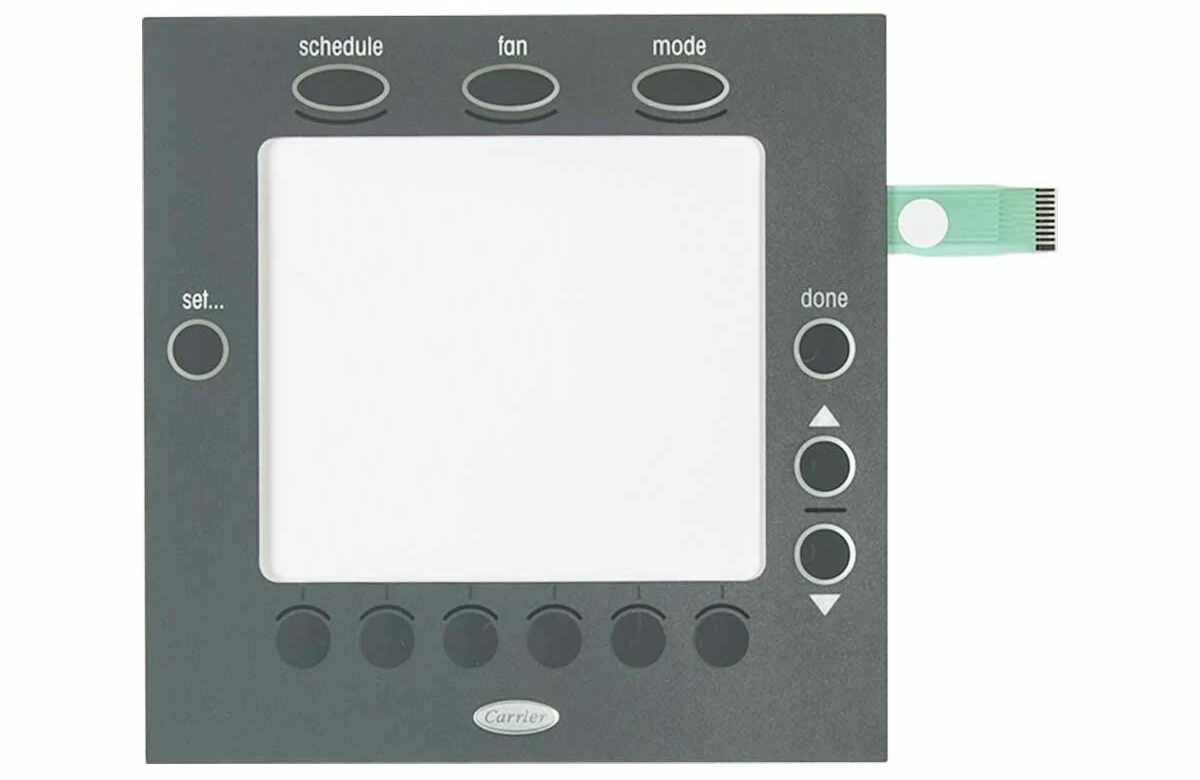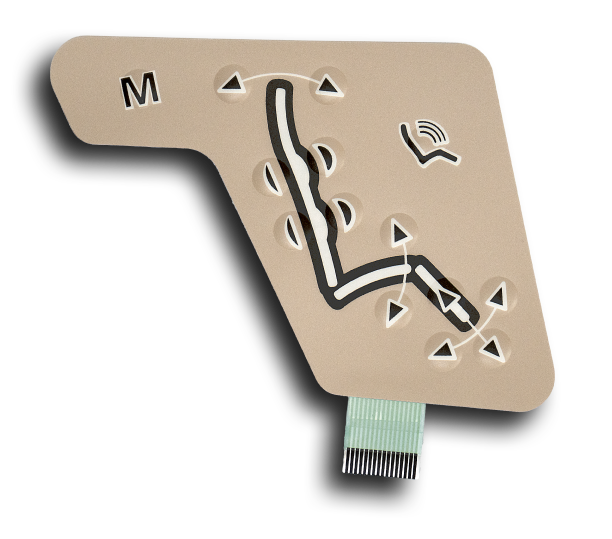Membrane Switch Manufacturer Focused on User-Centered Design
Membrane Switch Manufacturer Focused on User-Centered Design
Blog Article
Checking Out the Production Refine of Membrane Switch for Different Industries
The manufacturing procedure of Membrane switches is a complex endeavor that demands accuracy and interest to detail. From choosing proper products to implementing strenuous high quality control actions, each step plays an essential role in guaranteeing performance. Numerous markets, including clinical and vehicle, depend on these elements for their unique applications. Understanding the ins and outs of this process reveals considerable insights into exactly how these switches are created and their influence across varied sectors.
Recognizing Membrane Switches: A Review

Secret Products Utilized in Membrane Switch Production
In Membrane switch manufacturing, the option of key materials substantially affects capability and resilience. Conductive products, adhesives, and finishes play crucial roles, while substrate selection impacts overall performance and dependability. Comprehending these parts is vital for maximizing the design and production of Membrane switches.
Conductive Materials Review
Conductive materials play an important function in the capability of Membrane buttons, ensuring reliable electric connections within the device. Commonly made use of materials consist of silver, copper, and carbon-based inks, each offering distinct benefits. Silver is preferred for its high conductivity and sturdiness, making it suitable for applications calling for durable efficiency. Copper, while a little less conductive than silver, is an economical alternative typically used in published circuits. Carbon-based inks offer a functional alternative, appropriate for applications where adaptability and reduced costs are prioritized, although they have reduced conductivity contrasted to steel options. The option of conductive materials straight impacts the overall dependability, lifespan, and efficiency of the Membrane switch, making it an important factor to consider in the production procedure.
Adhesives and Coatings
Adhesives and finishes are important elements in the production of Membrane buttons, providing important bonding and safety homes. These products ensure that different layers of the switch, consisting of graphic overlays and wiring, adhere safely to one another, boosting sturdiness and functionality. Typically used adhesives consist of pressure-sensitive adhesives (PSAs) and epoxy-based solutions, which provide strong bond and strength. Coatings, such as polyurethane or acrylic, offer to safeguard against ecological factors, consisting of moisture, abrasion, and chemicals. Furthermore, layers can improve tactile responses and visual allure, adding to the total individual experience. The selection of ideal adhesives and finishings is important for maximizing performance and durability in diverse applications throughout numerous industries, guaranteeing that Membrane switches over satisfy specific operational demands.
Substrate Option Variables
Substratum selection plays an important role in the production of Membrane buttons, as it substantially affects their overall performance and longevity. Secret materials such as polyester, polycarbonate, and versatile printed circuit boards (FPCBs) are generally used for their distinct buildings. Polyester is preferred for its cost-effectiveness and resistance to abrasion, making it ideal for applications with high wear. Polycarbonate offers premium clearness and effect resistance, ideal for atmospheres calling for high presence. FPCBs supply improved versatility and are often used in intricate styles. The choice of substrate also affects aspects like thermal security, chemical resistance, and ease of printing. Ultimately, picking the suitable substratum is vital for ensuring the performance and durability of Membrane switches over across numerous sectors.
The Layout Process of Membrane Changes
The layout process of Membrane switches is an important phase that considerably influences the capability and aesthetics of the end product - membrane switch manufacturer. It starts with defining the particular needs of the application, including measurements, switch layout, and responsive feedback preferences. Developers should think about user interaction, guaranteeing that the button is instinctive and accessible.Next, materials are selected based upon sturdiness, flexibility, and ecological resistance. The integration of graphics and branding components is also essential, as it enhances aesthetic appeal and communication. Prototyping enables repetitive screening, allowing changes based on user feedback and performance evaluations.Additionally, the style should make up the electric parts, such as adapters and circuits, guaranteeing reliability and ease of use. Inevitably, an effective layout balances performance, aesthetics, and navigate to these guys individual experience, leading the way for reliable production and durable efficiency in numerous markets
Printing Methods for Membrane Switches Over
The printing methods used in Membrane button manufacturing play an important role in figuring this link out the last product's quality and capability. Display printing provides advantages such as sturdiness and dynamic shade application, while digital printing developments offer adaptability and accuracy in design. Comprehending these methods can considerably impact the overall performance of Membrane buttons in various applications.
Display Printing Benefits
Various benefits make display printing a recommended strategy for generating Membrane switches. This approach permits high-quality, lively shades and thorough designs, which are essential for interface applications. Screen printing is particularly efficient for using thick ink layers, boosting toughness and responsive feedback. Additionally, it offers excellent adhesion to numerous substrates, making certain longevity sought after environments. The process is cost-effective for huge production runs, as it reduces configuration time and waste. Additionally, display printing sustains a wide variety of inks, including specialty and UV-curable options, allowing convenience in layout. Its ability to produce consistent results throughout numerous devices makes it a trustworthy option for producers intending for quality and effectiveness in Membrane switch production.
Digital Printing Innovations

Improvements in electronic printing modern technology are transforming the production of Membrane buttons, using makers ingenious services that enhance design adaptability and efficiency. Digital printing permits high-resolution graphics and complex designs, making it possible for personalized branding and capability without the restrictions of standard techniques. This technique minimizes setup times and expenses, assisting in much shorter manufacturing runs and very little waste, making it perfect for companies with differing needs. In addition, improvements in ink formulations supply much better durability and bond, ensuring durability in different environments. As markets progressively seek complicated and customized styles, digital printing sticks out as an essential method, establishing a new criterion in Membrane button manufacturing. The assimilation of these technologies placements suppliers to satisfy progressing market needs efficiently.
Setting up and Layering of Membrane Switch Components
Mindful setting up and layering of Membrane button parts are necessary to assuring capability and durability. This process begins with the accurate positioning of different layers, including the visuals overlay, sticky, circuit layer, and support product. Each part has to be meticulously positioned to keep electric stability and interface responsiveness.During setting up, conductive traces are related to the circuit layer, normally made from products like polyester or polycarbonate. This layer is essential, as it sends signals when stress is used. The glue made use of for bonding these layers is likewise selected for its capability to withstand environmental stresses while maintaining a safe and secure bond.Heat and stress are often used throughout the assembly process to ascertain that the layers adhere effectively without endangering the performance of the switch. Focus is given to the side securing to shield versus wetness and contaminants, protecting the long life of the Membrane switch in numerous commercial applications.
Quality Assurance Procedures in Membrane Switch Manufacturing
Quality assurance actions play an important role in ensuring the dependability and performance of Membrane changes following the setting up and layering of their components. In the manufacturing process, several key evaluations are carried out to promote top quality standards. click These consist of aesthetic inspections for problems in printing and adhesive application, in addition to useful examinations to verify the responsiveness of each switch.Additionally, environmental screening is performed to examine the buttons' durability versus temperature changes and moisture exposure. Suppliers usually apply statistical procedure control (copyright) methods to monitor production consistency, enabling early discovery of anomalies.Furthermore, traceability systems are established to track products and parts, ensuring responsibility and assisting in recalls if essential. Calibration of equipment and adherence to industry requirements are additionally vital to preserving product stability. Collectively, these top quality control measures safeguard the performance of Membrane switches across various applications, eventually boosting client contentment.
Applications of Membrane Switches Over Throughout Different Industries
Membrane switches are made use of throughout a varied range of markets, showcasing their adaptability and flexibility. In the clinical field, they supply water resistant and reputable interfaces for tools such as diagnostic tools and mixture pumps, making sure health and convenience of use. The automobile industry employs Membrane switches for dashboard controls, enabling smooth communication in between the motorist and car systems.In consumer electronic devices, these buttons are discovered in home appliances and handheld devices, offering a smooth, modern-day visual while boosting performance. Industrial applications also utilize Membrane switches for equipment control board, where longevity and resistance to rough problems are essential.Furthermore, the aerospace and defense sectors make use of Membrane buttons for cockpit instrumentation and interaction systems, focusing on reliability and efficiency under extreme conditions. On the whole, Membrane switches play an important role in boosting the user experience and functional efficiency throughout various domain names.
Often Asked Inquiries
For how long Does It Require To Make a Membrane Switch?
The manufacturing time for a membrane layer switch commonly ranges from a few days to numerous weeks - membrane switch manufacturer. Variables influencing this period include style intricacy, material accessibility, and manufacturing quantity, all impacting the general timeline significantly
What Is the Regular Life-span of a Membrane Layer Switch?
The common life expectancy of a membrane layer switch generally varies from 1 to 5 million actuations, depending upon aspects such as material high quality, environmental conditions, and usage regularity, greatly impacting toughness and total performance.
Can Membrane Switches Over Be Personalized for Details Applications?
Membrane buttons can indeed be personalized for specific applications. Their style flexibility enables modifications in size, form, shades, and graphics, making certain compatibility with unique demands across numerous industries and enhancing functionality and user experience.

Are Membrane Switches Ecologically Friendly?
The ecological influence of Membrane switches over varies. Some products used might not be eco-friendly, while advancements in making processes are progressively focusing on sustainability, intending to lower waste and advertise recyclable elements in their manufacturing.
What Are the Usual Failure Modes of Membrane Switches?
Common failing settings of Membrane buttons consist of delamination, adhesive failing, damage from usage, dampness access, and electrical failures. These issues can substantially impact capability, performance, and lifespan in different applications across different markets. Membrane switches can be customized to fit specific style needs, such as capability, form, and dimension, making them very adaptable.The construction normally includes several layers, including a graphic overlay, glue, and a circuit layer, which work with each other to develop a smooth customer experience. In Membrane button production, the choice of key materials significantly affects capability and resilience. The automobile industry employs Membrane switches for dashboard controls, enabling seamless communication between the motorist and vehicle systems.In consumer electronic devices, these buttons are located in devices and portable gadgets, using a smooth, modern aesthetic while enhancing capability. Industrial applications additionally utilize Membrane changes for equipment control panels, where durability and resistance to harsh problems are essential.Furthermore, the aerospace and defense markets use Membrane buttons for cabin instrumentation and communication systems, focusing on integrity and performance under extreme conditions. Membrane buttons can without a doubt be customized for details applications.
Report this page